The 2016 Razer Blade Pro Review
by Brandon Chester on March 6, 2017 8:00 AM EST- Posted in
- Laptops
- Razer
- Razer Blade Pro
GPU Performance
The headline feature of the 2016 Razer Blade Pro is definitely its use of NVIDIA's GTX 1080 GPU. NVIDIA's Pascal generation of GPUs has brought us to the point where you really can get essentially the same GPU performance from a laptop as a desktop, although the base clock speed is slightly lower than its desktop counterpart, and thermals can play a large role in laptop performance. GTX 1080 is still NVIDIA's flagship GPU, and the Blade Pro is the first machine I've seen with it that isn't a ridiculously bulky desktop replacement laptop.
In theory, using GTX 1080 does get you about the same performance as a desktop with the same GPU, but as I mentioned before, thermal constraints can cause a gap in performance. Other factors like the speed of the CPU can also have an impact, so it's important to properly evaluate the Blade Pro even though knowing the specifications already provides an idea of how well it will perform. With that in mind, I've run the Blade Pro through our standard GPU workflow for laptops.
3DMark
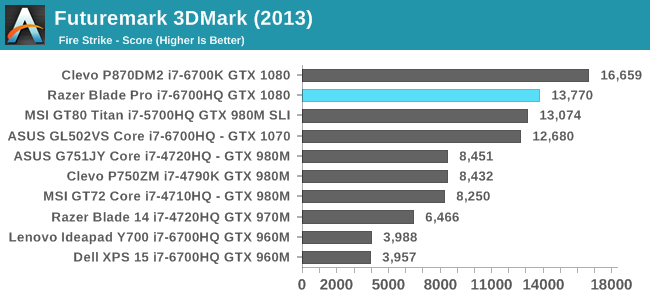
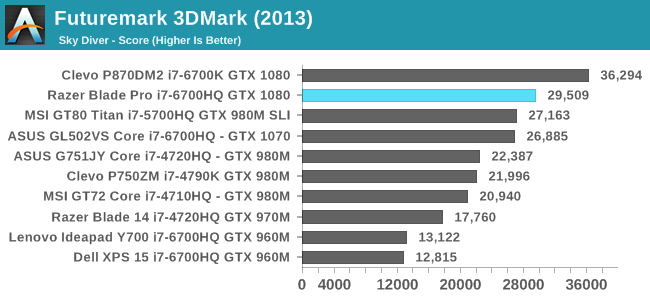
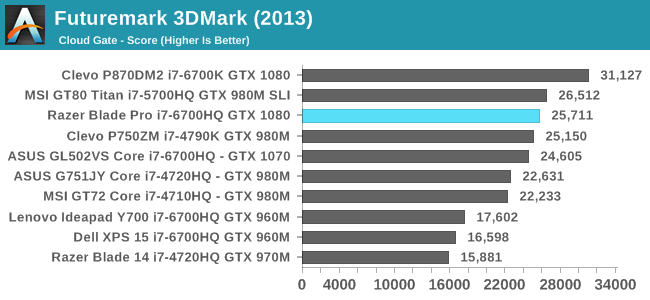

3DMark has evolved over the years to match the increasing performance of GPUs. In the newer, more GPU-intensive tests like Fire Strike, Sky Diver, and Cloud Gate, the Razer Blade Pro is right near the top of the chart. In Fire Strike and Sky Driver it wins against the MSI GT80 with it's dual GTX 980M GPUs, but it comes in a bit lower in Cloud Gate. The Clevo P870DM2 always comes in first as a result of its faster desktop CPU, which isn't unexpected. Overall, 3DMark shows the strong performance of NVIDIA's GTX 1080 and the Blade Pro.
GFXBench

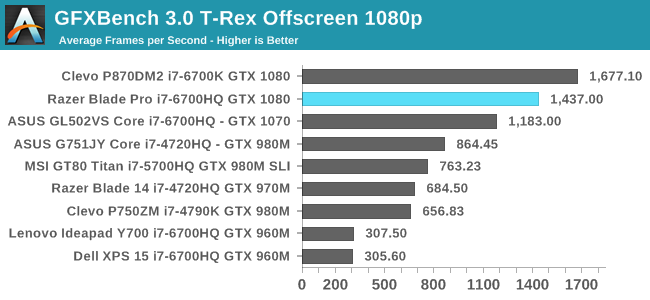
GFXBench basically exists for testing lower-performing laptops, as well as to verify that nothing is wrong with a laptop's performance for OpenGL titles. The Blade Pro performs as expected in both cases, sitting between the Clevo P870DM2 and the ASUS ROG Strix.
Dota 2 Reborn
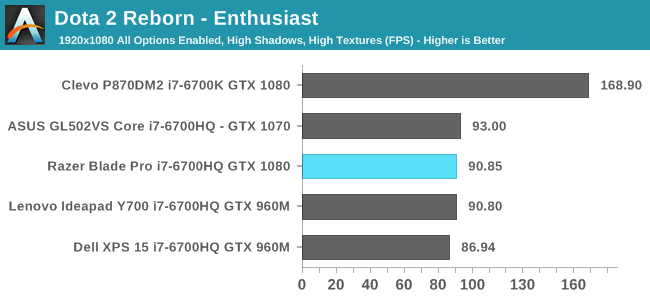
Dota 2 is really CPU-bound at this point, with all the 6700HQ-based laptops achieving similar levels of performance. While the Blade Pro is at the same level as ASUS's GTX 1070 ROG Strix, the Clevo P870DM2 with its i7-6700K is nearly twice as fast as the Blade Pro despite using the same GPU. Ultimately this situation isn't unexpected for Dota 2, and the Blade Pro won't have any trouble with it even if the resolution is increased beyond the 1080p resolution that we test at.
Tomb Raider

Tomb Raider is perhaps the best showing for the Blade Pro, with performance being very close to that of the Clevo P870DM2, and significantly faster than any of the other laptops that we've tested.
Rise of the Tomb Raider

Rise of the Tomb Raider is a newer addition to our benchmark suite, so there aren't many results at this point. However, the order of the top results here mirrors the previous Tomb Raider test, with the Clevo P870DM2 at the top, followed by the Blade Pro, and the ASUS ROG Strix coming in third.
Civilization VI



Civ VI is a relatively new addition to the benchmark suite, and the only other laptop on record is the ASUS ROG Strix. As usual, Civ remains a more CPU-bound title, and with the same i7-6700HQ the Blade Pro performs essentially the same as the ROG Strix despite the difference in GPUs. Using one of Intel's faster CPUs would have helped differentiate the Blade Pro from other laptops in these CPU-bound titles, which would have avoided the awkward situation where a $3700 laptop doesn't perform any better than one which is less than half the price.
Bioshock Infinite
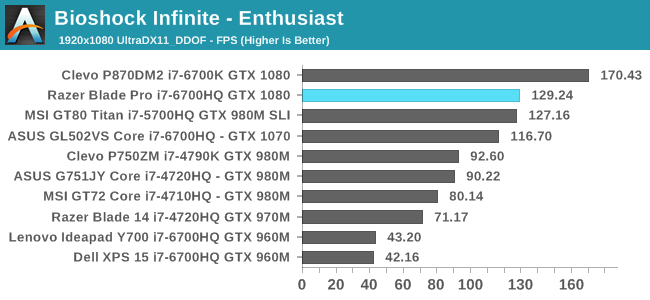
Bioshock Infinite is a case where the Blade Pro falls pretty far behind the Clevo P870DM2. I actually find the result of the P870DM2 to be somewhat questionable, as it seems higher than I would think is possible, so I can only assume that it must have been a really lucky run. In this case the Blade Pro performs slightly better than the MSI GT80 with its pair of GTX 980M GPUs, which is still quite a feat.
Dragon Age: Inquisition
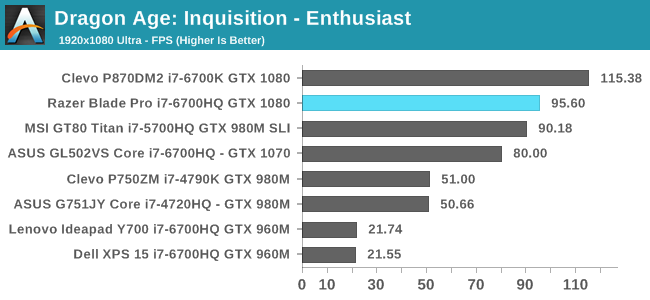
Dragon Age: Inquisition is one case where the Blade Pro is actually closer to the ASUS ROG Strix with its GTX 1070 than the Clevo P870DM2 which also uses GTX 1080. This is really something that depends on the game, and whether there are situations where the CPU becomes the limiting factor for performance. The performance is still significantly better than the GTX 1070, and noticably faster than a pair of 980Ms.
Shadow of Mordor
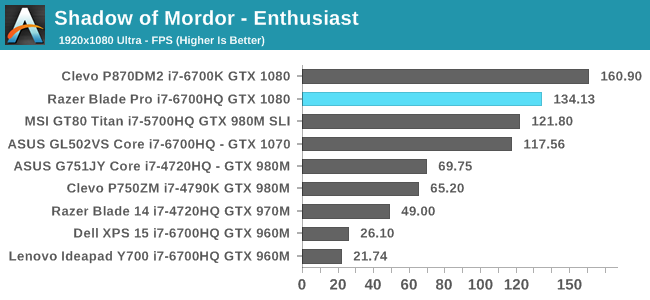
The Blade Pro performs well in Shadow of Mordor, although this is another case where the frame rate is slightly closer to that of the ASUS ROG Strix with its GTX 1070 GPU than the Clevo P870DM2. Still, the performance is quite impressive, especially when you consider how the Blade Pro is again surpassing the performance of the MSI GT80 which used a pair of GTX 980M GPUs and was the performance leader for laptops until the launch of NVIDIA's Pascal parts.
Grid Autosport
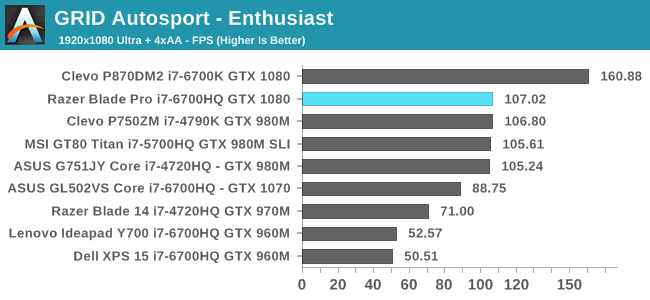
GRID is another case where machines become CPU limited at our test settings. The Blade Pro sits alongside several other laptops with lesser GPUs, while the Clevo P870DM2 has a large lead because of its desktop i7-6700K CPU. While Razer couldn't have put a 91W desktop CPU in their laptop, using a faster quad core mobile part could have improved performance here.
GPU Conclusion
When I first looked into gaming laptops many years ago as an interested consumer it was typically the case that NVIDIA's mobile parts reflected the performance of the GPU three tiers below that of the desktop card with a matching name. The performance that you can achieve in a notebook has gone up substantially since that time, and we're now seeing what are basically desktop parts shipping in laptops. In the case of the Razer Blade Pro, you have NVIDIA's GTX 1080, which is their flagship card for notebooks.
In the tests above it's clear that the Razer Blade Pro is one of the fastest notebooks on the market. The GTX 1080 provides a substantial increase in performance compared to laptops like the ASUS ROG Strix which use GTX 1070. However, if you were expecting the same performance as Clevo's P870DM2 you may be feeling somewhat left down. I was initially suprised by the gap, especially with the Razer Blade Pro being closer to the ROG Strix than the P870DM2 in some situations. After some examination, I've concluded that there isn't really any GPU throttling occuring, and looking at the titles where the gap is largest makes it evident that we're seeing the impact of differing CPUs. The Blade Pro's 2.6GHz i7-6700HQ is no slouch, but it's not going to keep up with a 4GHz i7 sitting in a desktop replacement that's twice as thick.
While this situation is unavoidable, there are two things I want to highlight. The first is that Razer could have, and should have used i7-6920HQ. I mentioned that on the previous page, and it bears repeating here. The Blade Pro is a premium laptop that starts at $3699. It's a machine that spares no expense, and it should be using Intel's fastest quad core chip. This would help in narrowing the gap between it and the P870DM2, and I'm pretty sure Razer would still bring in a healthy margin on the laptop.
The other point I wanted to mention is that the gap between the Blade Pro and the P870DM2 will be diminshed when running games at UHD. At that point the GPU becomes the limiting factor, and the difference in CPU performance has a smaller impact. Unfortunately, a single GTX 1080 really isn't sufficient to run modern titles at UHD unless you reduce the graphical settings to a point where the game probably looks worse overall than it did maxed at 1080p.
Ultimately, the Razer Blade Pro is still an incredibly fast machine, and 1080p is a perfectly suitable resolution to run games at on a 17-inch display. For example, I played through Deus Ex: Mankind Divided at max settings on the Blade Pro at 1080p and I was never bothered by scaling artifacts or aliasing. For $3699 I think Razer should have put in the fastest possible CPU in order to maximize performance, but as it is the Blade Pro is still highly capable and should be able to run modern games at high settings for the forseeable future.










57 Comments
View All Comments
Eden-K121D - Monday, March 6, 2017 - link
Who'll buy this?Ninhalem - Monday, March 6, 2017 - link
From the article: "The 2016 Razer Blade Pro is a great gaming laptop. I certainly wish I could afford one for myself. My life right now is characterized by frequent moving due to work and university, and something like the Blade Pro would allow me to bring an incredibly powerful machine with me wherever I go. While the Blade Pro fulfills its role as a high performance gaming machine, it did let me down as a mobile workstation."The last sentence feels like an unintended scenario for this laptop. Mobile workstation to me says you need to do activities like CAD and/or purely business work, and requires a CAD card instead of the mainstream variant. This laptop's intended audience clearly isn't the business world.
fanofanand - Monday, March 6, 2017 - link
No $4,000 laptop should be usable ONLY for gaming, any other laptop in this price range is a jack of all trades sans military laptops.Brandon Chester - Monday, March 6, 2017 - link
Yeah that was my point. I'm actually willing to shell out $3700 on a laptop if it can replace every other computer in my life. If it can only replace a gaming machine then it's going to be limited to the niche of users who can afford paying that much just to bring their games around with them.akdj - Tuesday, March 14, 2017 - link
I'm with ya Brandon - always have been, as my laptop pays my mortgage, son's tuition, and wife's car payment;)As an OS X/macOS user over the last decade, their last half year 'computationally, has excited me as much as a three hundred mile road trip to grandpa and grandma's in the station wagon as a kid. And I can't be totally sure, but I think I might not be their 'audience' any longer...kinda feel unwanted after a pair of 17" 2008/2011 & two 15s in the Intel era, 2012 and 2015. Plenty between my '83 IIe and current 2015 15"
... I was very excited for your review
Needless to say, I'm shocked at the results (even in comparison w/their small 14" model you reviewed, as the objective 'scores and analysis' are in the charts with both machines represented!)
Oh well, always a compromise
DanNeely - Monday, March 6, 2017 - link
From a few sentences later in the article it's clear that he's talking about a image/video editing workstation not a CAD box; for the former only the screen is really holding it back.QuinRiva - Monday, March 6, 2017 - link
Mid level technical professionals... The business is buying it, so the price is pretty insignificant compared to salary and overheads. Sure, most of my workload is offloaded to a DB or compute node somewhere, but loads of prototyping and presentation workload is done on the laptop/client side.Quadcore is essential just to run things like Excel/Tableau, and a decent graphics card is useful for Illustrator, or running neural nets; or spending a bit of time relaxing playing a game on an international business trip.
And if they want "pro" buy-in, it has to look like a professional tool - I can't turn up to a client meeting with a flashing garish "gaming laptop". The XPS 15 is a pretty good compromise on this front, it's just a pity it was limited to GTX 960M.
milkod2001 - Thursday, March 9, 2017 - link
Rich kidz who play games and content creators who think that their web sized images will somehow load on this machine faster...Price is ridiculous, screen, GPU & CPU should not cost more than 1000, the rest 500 leaving 500 margin for Razor if sold at realistic $2000 but no this costs $3699. What a joke.
fanofanand - Monday, March 13, 2017 - link
That GPU alone was $700 in the desktop form up until a couple weeks ago, and the "recommended" price on that CPU is $378. I know Razer isn't paying retail on these things but if you believe $1,000 for the screen, CPU and CPU "should not cost more than 1000" then I think you are unaware of component prices. Yes this thing has huge margins, yes it's ridiculously overpriced, but I think your numbers are pure fantasy.digiguy - Monday, March 6, 2017 - link
One negative aspect seems to be unanimously mentioned by all reviewers: the keyboard is crap. Which, for a laptop, is a big negative.